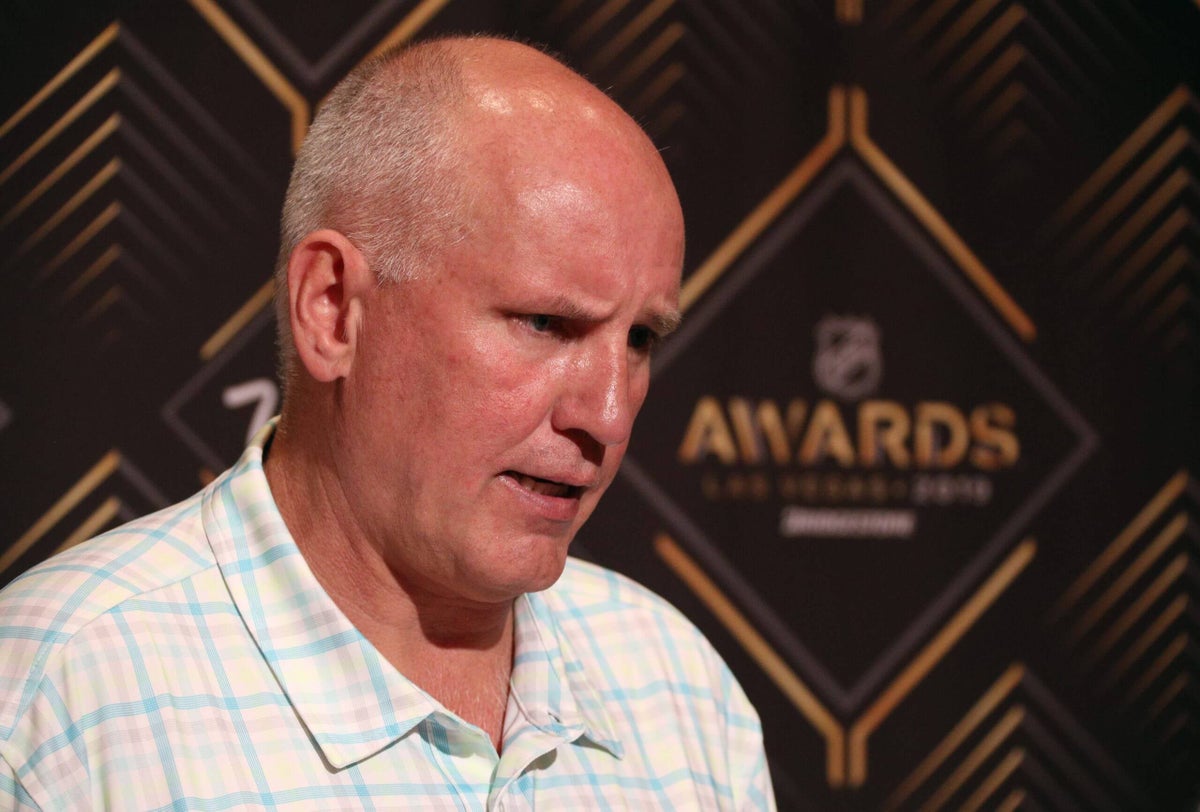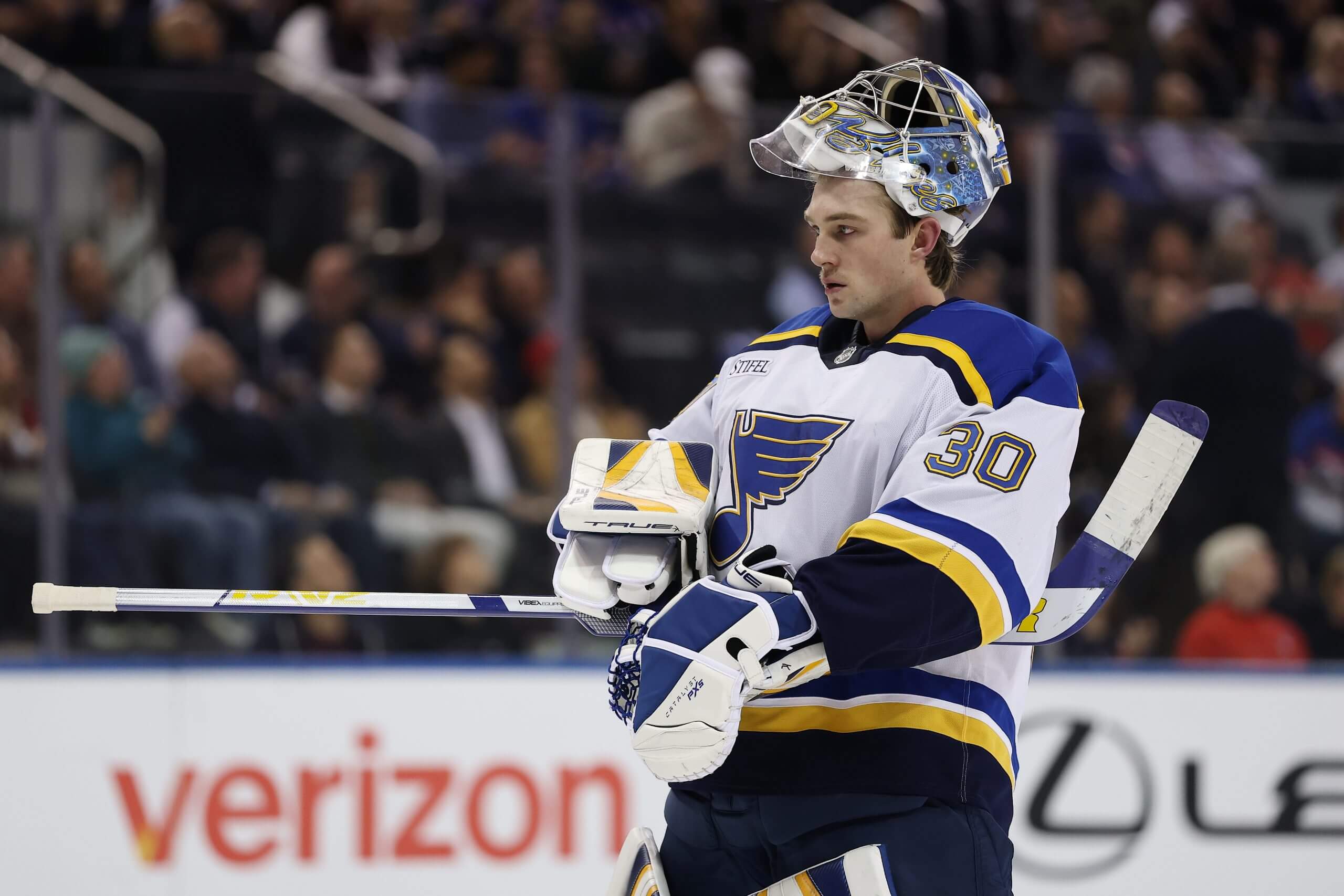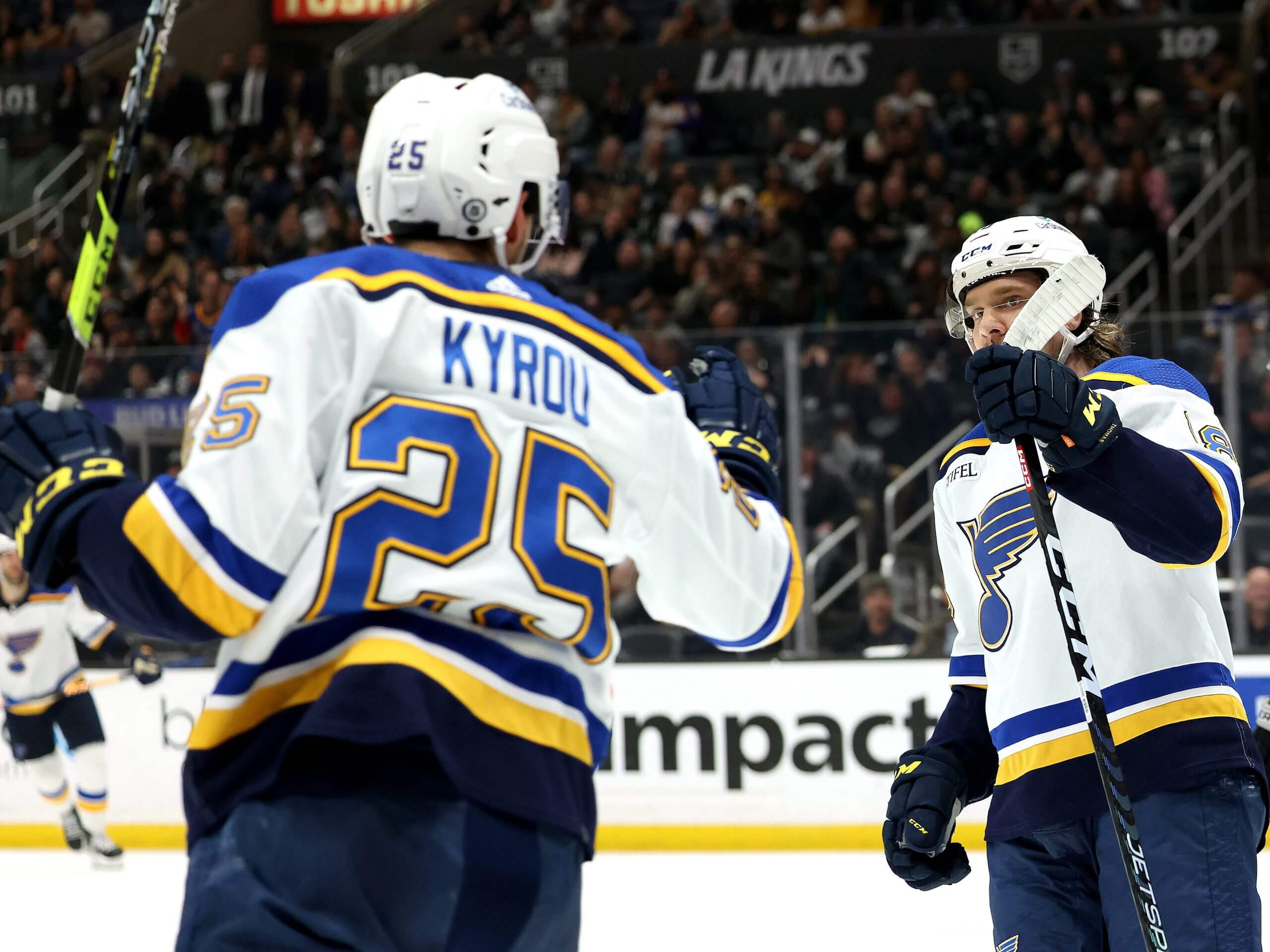ST. LOUIS — Heading into the offseason in early June, St. Louis Blues general manager Doug Armstrong created some intrigue when he mentioned the need to add a “200-foot center.” Who could that be?
If it’s not one of the top free-agent targets on The Athletic’s big board, perhaps it’s someone from the second or third tier?
Three weeks after the comment was made, and with NHL free agency coming July 1, Armstrong acknowledged Monday in a 40-minute Q&A with reporters that such a player would be too costly for the Blues to indulge.
“I believe that player’s out there, but it took me a little time to realize that COVID’s over, in the sense of how agents and people expect the new market to be,” Armstrong said.
For context, the NHL salary cap was $59.4 million in 2010-11 and jumped more than $20 million to $81.5 million by 2019-20.
“The cap would grow $5 to $6 million a year, and any bad contract you did — perceived bad contract — within two years, it wasn’t a bad contract because the cap had gone up so much that it made it a livable contract,” Armstrong said.
But from the start of COVID-19 in March 2020 until the 2023-24 season, the cap went up just $2 million, to $83.5 million. In Armstrong’s words, the flat cap didn’t allow for bad contracts because teams were forced to make good business decisions.
This season, however, the cap is rising to $95.5 million, and it’s projected to be $113.5 million by 2027-28. As a result, Armstrong said players heading into free agency are asking for contracts that will look good now — and in a few years, too.
“If you want to get a free agent and you go through the analytics, and you chart what a guy’s going to make, probably add 20 percent in another year, and that gets you in the conversation (for them) to say ‘no’ to you,” Armstrong said. “But if you don’t get into that, you have no chance at getting in the conversation.”
Call it Armstrong backtracking on his previous comment, or whatever you want, but on Monday, he made it sound as if the Blues won’t be as active as he envisioned.
“I do believe that July 1 is going to be a fireworks day and there could potentially be some good-valued players July 15,” he said. “I’m not saying we’re not going to be active July 1, talking and finding out who’s out there, what it is. But I can see the headlines now: ‘Wow, (teams around the NHL) overpaid for him.’ We’re not bargain shopping. It’s not like we’re afraid to get in the other market, but it would have to make sense for us to do that.”
Here are other takeaways from Armstrong’s pre-draft availability.
Offer sheet for Hofer?
Fans have shown some concern recently about the possibility of goaltender Joel Hofer, who will be a restricted free agent if not re-signed by the Blues by July 1, receiving an offer sheet this summer.
Armstrong confirmed Monday that the Blues are negotiating with Hofer and that the team is not concerned about the situation.
“He’ll get a qualifying offer and he’ll take us to arbitration, or we’ll take him to arbitration,” Armstrong said.
The GM also isn’t concerned about Hofer receiving an offer sheet if he becomes an RFA.
The Blues will have approximately $13.3 million in cap space for the 2025-26 season after they put defenseman Torey Krug on long-term injured reserve. (Armstrong said Monday that Krug will not play next season.)
The compensation the Blues would receive if another team signed Hofer to a contract with a cap hit between $2.3 million and $4.6 million would be a second-round pick. The return for a deal with a cap hit between $4.6 million and $7 million would be a first- and a third-round pick.
“We’ve taken the Boston-Detroit approach last year when they had RFAs,” Armstrong said. “They made sure they left enough cap space that any offer could be matched. I’m very comfortable we can match any offer if we choose to match it. It won’t be we didn’t match it because we couldn’t afford it. It will be we didn’t match it because we thought the value we were getting back was better, and that value would have to start with a first-round pick or else we’ll just match it.
“I’m not saying we wouldn’t match it with a first either, but I guess this is my shot across the bow. You can go after him. You’re not going to get him.”
Doug Armstrong said the team is not worried about losing Joel Hofer as an RFA. (Sarah Stier / Getty Images)Updates on Faksa, Suter
The Blues have two pending unrestricted free agents in Radek Faksa and Ryan Suter, and Armstrong acknowledged Monday that they are only talking to Faksa at the moment about coming back.
“We’ve had conversations, and we’ll find out by July 1,” Armstrong said.
As for Suter, Armstrong spoke to him about the team moving forward with Colton Parayko, Cam Fowler, Philip Broberg, Justin Faulk, Nick Leddy, Tyler Tucker and Matthew Kessel.
“I mentioned the seven D that we have, and (Suter) understands that,” Armstrong said.
Re-signing eligible players
Fowler, Broberg and forward Dylan Holloway are entering the final seasons of their contracts in 2025-26 and are eligible for extensions beginning July 1.
Fowler, 33, would become a UFA after the 2025-26 season, while Broberg and Holloway, both 23, would become RFAs.
“We’re not in any rush,” Armstrong said. “Fowler is a guy, he’s going to be unrestricted; the other two guys aren’t going anywhere. Worst-case scenario is they go to arbitration a year from now. If we have cap space now, we’re going to have millions more next year.
“I don’t plan on having any big conversations prior to next season. Cam is a hell of a player — hell of a year — (but) if he was 26, the dynamic changes. (Broberg and Holloway) have got years before they’re UFAs. We would love those players to stay here well past next year, but it’s not something that is a priority that we feel has to be accomplished in July.”
Improving the D
Those seven defensemen may be on the Blues’ opening-night roster, but Armstrong acknowledged Monday that he will look to improve the group if he can.
“I think if we came back with the four that ended the year (Parayko, Fowler, Broberg, Faulk), if they played a whole year together, it’s not the best top four in the league but it’s certainly above average,” he said. “We do want to see what Tucker can do. We do want to see what Kessel can do. We do know what Leddy can do. So we have seven guys there. Now, if you could improve it, yeah, we would look at doing that.”
The full no-trade clauses for Faulk and Leddy will change to modified NTCs soon. On June 30, Leddy can submit a list of 16 teams to which he can be traded. On July 1, Faulk can provide a 15-team no-trade list.
That timeline wouldn’t allow the Blues to free up money before free agency, but if they went that route, they could still make moves this offseason.
“I think there will be plenty of time,” Armstrong said. “If we move guys, it’s to open up spots more than it is to open up money, just because of the number of players we have returning. If we were to get into a market, it would probably be moving a guy just because we need to create space for a guy to play.”
Kyrou’s NTC
The defensemen aren’t the only ones with changes coming to their NTCs. Captain Brayden Schenn switches from a full clause to a modified NTC in which he must provide a 15-team no-trade list by July 1. And the Blues have two players, Jordan Kyrou and Robert Thomas, whose full NTCs from the matching eight-year, $65 million contracts they signed in 2022 will kick in July 1.
Asked in general terms Monday if he sees an NTC kicking in as a deadline to trade a player if that’s the team’s desire, Armstrong indicated he views it as any other day on the calendar.
“Dates come and go in our business, whether it’s a no-trade clause kicking in or a trade deadline, whatever,” he said. “You don’t really focus on it. It is what it is.”
Jordan Kyrou and Robert Thomas have trade protection kicking in this summer. (Harry How / Getty Images)Draft plans
The first round of the NHL Draft is Friday, with Rounds 2 through 7 on Saturday.
The Blues have just three selections after sending their second- and third-round picks to the Edmonton Oilers as compensation for signing Broberg and Holloway to offer sheets.
“It is different, but we believe the value in Broberg and Holloway was worth the second and third,” Armstrong said. “That’s just the price of doing business.”
Armstrong said the Blues are confident they can get a good player with the 19th pick in the first round but aren’t opposed to trading it for an NHL roster player.
“It’s definitely in consideration, yes,” he said. “What I don’t think we’re going to do is deviate from our course of trying to build within a group of players that are (age 20 to 25). That’s sort of that window that we’re trying to input players into. We could trade No. 19 for a player that’s one year away from UFA, and then hope you can sign them. But if you can’t sign them, he walks away a year from now and people say, ‘Why’d you do that?’ We won’t be trading for a guy with one year left unless we know 100 percent that we can get him signed.”
Development camp
The Blues will host their annual development camp from June 30 to July 3, and defensemen Adam Jiricek (2024 first round) and Theo Lindstein (2023 first round) will be in attendance.
Jiricek, who was drafted by the Blues at No. 16 last year, played just 27 games with OHL Brantford because of a series of injuries.
“He is all ready to go,” Armstrong said. “He needs to put a solid, healthy year together. We’ve talked about that in the past. It’s hard to make the club from the tub. Sometimes you can’t control it. I’m not saying he can control these injuries he has, but you have to be able to play. We need to see it. He needs to see it. It’s reality. You have to stay healthy to prove how good you are.”
As for Lindstein, who was drafted at No. 29 two years ago, he will be playing in North America this season, like fellow Swede Otto Stenberg (2023 first round) did last season, arriving in AHL Springfield midseason.
“Theo is coming next (season) for sure,” Armstrong said. “Stenberg came halfway last year, but Theo is coming.”
Any buyouts?
For those wondering the Blue are going to buy out any players, like The Athletic projected could happen with forward Mathieu Joseph, the answer is no.
“Nothing on the horizon — unless it’s me,” Armstrong said, laughing.
(Top photo of Doug Armstrong: Bruce Bennett / Getty Images)


